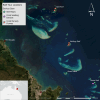Reef visitors' observation of assisted coral recovery devices in situ reduces concern about their use
- PMID: 39514555
- PMCID: PMC11548783
- DOI: 10.1371/journal.pone.0313345
Reef visitors' observation of assisted coral recovery devices in situ reduces concern about their use
Abstract
Assisted coral recovery (ACR) initiatives are establishing rapidly in coral reefs worldwide, using a variety of devices and techniques. In the Great Barrier Reef (GBR, the Reef), site-scale ACR field trials are occurring at multiple sites in the Cairns-Port Douglas region through Reef stewardship activities involving GBR tourism operators, Traditional Owners, and not-for-profit organisations. It is hypothesised that these field trials and the presence of ACR devices at reef tourism sites do not negatively affect visitor experiences, and when accompanied by appropriate educational information, can potentially help to raise awareness of Reef stewardship and conservation efforts. We tested these hypotheses using a survey of 708 Reef visitors on five tourism vessels, 346 of whom reported observing ACR devices in situ during their coral reef experience. Ordinal regression tests of survey responses found no statistical relationship between respondents' observation of ACR devices and (i) their overall Reef trip satisfaction, (ii) the perceived aesthetic beauty of the site(s) they visited, and (iii) their concern about the future health of the GBR. However, Reef visitors who observed ACR devices showed significantly lower levels of concern about the use of these devices on the Reef. The perceived quality of educational information presented to respondents was among the significant factors associated with their reef trip satisfaction and perceived beauty of reef sites. Our findings have implications for ACR practitioners and proponents who are concerned about public visibility, perceptions, and support for ACR initiatives, as the scale of such initiatives is expected to increase.
Copyright: © 2024 Curnock et al. This is an open access article distributed under the terms of the Creative Commons Attribution License, which permits unrestricted use, distribution, and reproduction in any medium, provided the original author and source are credited.
Conflict of interest statement
The authors have declared that no competing interests exist.
Figures



References
-
- Eddy TD, Lam VWY, Reygondeau G, Cisneros-Montemayor AM, Greer K, Palomares MLD, et al.. Global decline in capacity of coral reefs to provide ecosystem services. One Earth. 2021; 4: 1278–1285. doi: 10.1016/j.oneear.2021.08.016 - DOI
-
- NOAA. NOAA confirms 4th global coral bleaching event. National Oceanic and Atmospheric Administration media release; 15th April 2024. Available from: https://www.noaa.gov/news-release/noaa-confirms-4th-global-coral-bleachi...
MeSH terms
LinkOut - more resources
Full Text Sources

